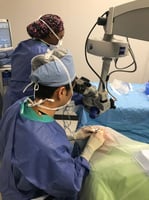At my practice, we do nearly all our procedures in our office-based surgery center. One of the most...
Anesthesia for Office-Based Cataract Surgery: Patient Expectations and Emerging Science
A major shift is underway in ophthalmic surgery as the eye care field reckons with evolving patient expectations and demands. This is amidst challenging reimbursement questions and the need to manage increasing case volume. Past decades have witnessed a steady migration of cataract cases operated in hospital settings to standalone surgical centers. A significant factor driving this trend is that the safety of the procedure itself. Outpatient procedures are now made convenient by ophthalmic suites. This is cost-effective, and provides a better experience for patients.
Now, a similar movement is occurring with the advent of office-based surgery (OBS). An increasing number of cataract cases are being performed in specially designed surgical suites. These suits are located within ophthalmic practices. With the move from hospital to ambulatory surgical centers (ASC), this assuses patients have access to the highest standard of safety in an office-based surgery suite. This at a lower cost, is a key reason why this transition has cataract surgeons across the country taking notice. A major factor in reducing costs is reducing the level of anesthesia for office-based cataract surgery.
Anesthesia Levels for Office-Based Cataract Surgery

The biggest question we get at iOR Partners is whether the level of anesthesia used during office-based cataract surgery poses any patient risk. Our answer is simple: cataract surgeries performed in an OBS are equally as safe as procedures performed in any other setting because the level of anesthesia is entirely appropriate to the level of care being provided. In fact, while there is good science that suggests milder sedation is sufficient (ie, Class A). We encourage partnering physicians to consider taking additional measures to ensure patients’ safety when it comes to anesthesia. Most iOR suites are accredited to accommodate various levels of anesthesia to include Class B level anesthesia.
Reporting the Facts
A 2016 study reported safety and effectiveness outcomes in more than 13,500 patients undergoing over 21,000 cataract surgeries in an office-based setting.1 Despite a not insignificant rate of preoperative comorbidities, the authors specifically noted that the safety profile was consistent with what has historically been found: in ambulatory surgery centers and hospital outpatient departments. Kaiser Permanente Colorado conducted the study where office-based procedures do not require intravenous access. There is also no anesthesiologist or nurse anesthetist present or on staff. Their research included a 2015 report detailing phacoemulsification performed on 6,961 eyes of 4,347 patients. 2 registered nurses assisted, without the dedicated presence of or access to anesthesia services. In that study, only 3 perioperative AEs (0.04% of cases) occurred that required emergency intervention. Of those, all were vasovagal collapse that resolved uneventfully without hospital admission. Thus, office-based anesthesia and cataract surgery can be performed safely in appropriate office-based settings.
A study was done on the level of anesthesia necessary for cataract surgery. It examined four parameters for patient experience and safety: pain scores, comfort level during the course of surgery, level of grogginess upon leaving the surgical center and over the course of the day, and whether the patients would recommend the surgery to friends or family, purely based on their experience in the operating room. The results showed that those who received Class A anesthesia had an experience of care and an overall favorability rating with surgery, which is equivalent to, and in some ways, exceeded those that received Class B anesthesia, with a safety profile appearing to be equivalent in both groups.2
Appropriate Levels of Anesthesia for Cataract Surgery
Collectively, these studies show that office-based surgery, with a majority performed under Class A anesthesia, is indeed safe and effective. The data supports that providing surgical services is under the minimum standard. iOR Partners works with surgeons so that they can offer Class B anesthesia when it is needed.
The real benefit of offering cataract surgery under Class A or B anesthesia is that either one can be available for use in an office-based surgical suite. When Class B is not available in the office, the surgeon can still schedule those cases at the ASC. Therefore, providers gain access to the myriad other benefits associated with running a fully functional operating suite in their clinic, including increased efficiency, personal ownership over the process, an engaged staff, and greater financial flexibility.
The reality is cataract surgery under milder sedation is not just safe, it is preferred by patients. Today’s cataract patients want to have a LASIK-like experience. Their expectation is that they will achieve an excellent outcome and have a positive experience throughout their surgical process. Demand for a quick recovery is the new norm and that can only be achieved by avoiding more than necessary anesthesia eliminating the post-operative feeling associated with deep sedation.
Conclusion
The nearly 4 million cataract surgeries performed each year are almost exclusively performed as outpatient procedures. Recent surveys suggest that the number could rise to close to 11 million over the next decade. Mounting evidence supports that cataract surgery procedures can be performed under milder forms of sedation. This is without any tradeoff in safety, whereas higher classes of anesthesia are themselves associated with a higher risk for complications.
It is rare, indeed, when emerging science strongly reinforces the whims of market demand. But when it comes to anesthesia requirements for cataract surgery in the office-based surgical suite, the case for the use of milder sedation, such as Class A anesthesia, is not only safe, it’s also what patients want and expect from their eye doctor.
References:
- Ianchulev T, Litoff D, Ellinger D, Stiverson K, Packer M. Office-Based Cataract Surgery: Population Health Outcomes Study of More than 21 000 Cases in the United States. Ophthalmology. 2016 Apr;123(4):723-8.
- Gangadhar B. Cataract Surgery: The Road to Fiscal SustainabilityThe Promise of the Triple Aim. Presentation at Kansas EyeCon 2019. April 26, 2019; Leawood, KS.

.png?height=200&name=Copy%20of%20Three%20Ophthalmic%20Industry%20Leaders%20Discuss%20Surgical%20Excellence%20with%20Office-Based%20Surgery%20(LinkedIn%20Post).png)
